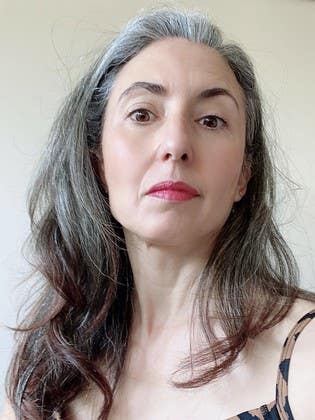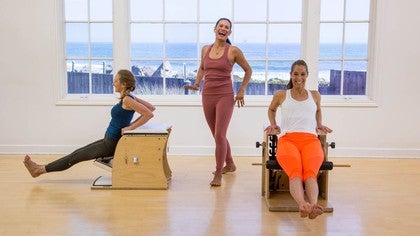
Pilates Teaching Tools: The Shapes of the Spine
“It has everything,” says Grimes, who studied with Joe and Clara Pilates at their New York City studio. “A two-way oppositional reach away from a strong center and a deep, full breath. If you look, you’ll find the Double Leg Pull in every exercise.”
Karen Frischmann, the creative impetus behind Balanced Body’s new Contrology springs and a co-founder of Vintage Pilates in Los Angeles, California, heard this statement from Jay in her very first lesson. “I went back to my studio and tried it.” she says.
Frischmann deliberately worked her way through all of the traditional Pilates exercises on the hunt for the Double Leg Pull. To her surprise and delight, she found it everywhere. Sometimes straightforwardly and more often hidden in plain sight, the Double Leg Pull had been there all along.
“‘We have only one exercise’ became the springboard for the creation of Vintage Pilates’ year-long master teacher’s program The Work, which was offered from 2012 to 2018 at the now-closed Vintage Pilates studio.
I’m a graduate of the inaugural class of 2012, and it was truly my favorite day of our Reformer Weekend when Jay simply instructed us to start our Reformer workout and imagine every exercise is the Double Leg Pull. What a freeing experience! And totally my jam.
What I didn’t know at the time was that this simple exercise would lead me to a deeper understanding of the cohesiveness of the Pilates System. It’s called a ‘method’ for good reason.
“Now that the Pilates industry has grown, many teachers have not had the chance to study with Joe’s original students. As a result, we are far removed from the originator of the method,” says Frischmann.
“How do we take what Jay does naturally and make it understandable to teachers?” asks Sandy Shimoda, owner of Vintage Pilates, which now operates online and on location. “How do we explain what we should be looking at? The five Spine Shapes developed as a teaching tool to make the work of Joe Pilates more understandable.”
“If you look at the shape of the spine you’re looking at the torso, and that’s where it’s all happening,” she adds. “Over time these teaching tools can create a common language.”
This focus on the shape of the spine reminded me of none other than Joseph Pilates. In his iconic manifesto, Return to Life Through Contrology, he tells us, “If your spine is inflexibly stiff at 30 you are old. If it is completely flexible at 60 you are young.”
I believe the strength and suppleness of the spine is the main tenet of the Pilates Method.
Frischmann and Shimoda organized the Pilates exercises into Five Spine Shapes, reflecting the shape of the trunk of the body in the exercise. “We found a vernacular term to describe the shapes of the trunk,” says Frischmann. The Five Spine Shapes (Tall, Round, Arch, Side Bend, and Twist) also help to illustrate how Joe’s work is a method rather than a random group of exercises.
- Tall Back is exemplified by exercises such as Going up Front on the High Chair and Leg Springs (supine Tall Back). I love the selection of this word as our back is ever-lengthening as we execute our Pilates exercises. The lift required in the Tall Back is also the foundation of all the other Spine Shapes.
- Round Back (think the Roll-Up, the Roll Over, and all our rolling exercises) denotes supported forward flexion. It is ‘supported’ because we are focused on supporting all of our movements with the strength of the center.
- Side Bend is supported lateral flexion: Side Reach on the Short Box, Side Bend on the Mat, and Mermaid fall into this category.
- Twist for supported twisting exercises such as Spine Twist, Corkscrew, and Saw.
- Arched Back describes the supported exercises that extend and hyper-extend the back: Swan, Breaststroke on the Reformer, and Rocking on the Mat are examples.
Do all of our Pilates exercises fall into one of these 5 shapes?
You may be thinking that many Pilates exercises don’t fit neatly into one of these 5 shapes. Yes, you are correct! As our exercises become more complex you’ll find two or three back shapes within the same exercise.
- Spine Stretch on the Mat includes a Round and a Tall Back.
- The Saw includes 3: Tall, Twist, and Round.
- Snake on the Reformer gives us Round, Twist, and Arched. No wonder it’s such a favorite! (Not.)
How can the concept of 5 Back Shapes help my teaching?
The Body Shapes allow us to efficiently describe complex exercises to clients by reminding them of skills they've achieved in simpler exercises that share the same shape. As a Pilates teacher, a big part of my job is to communicate and effectively deliver the Pilates method to my students.
The ability to relate the exercises to each other is a boon to learning. Students are able to relate new exercises to an exercise they’ve been practicing for a long time. Relating the exercises to each other also allows for the economy of words. Less talking means more moving.
Try it out in your next workout. Do a few Double Leg Pulls on the Mat and then go about your workout for the day and see if you can discover the Double Leg Pull in every one of your exercises. You may be delighted to find it lurking deep within even your most challenging exercises.
Comments


You need to be a subscriber to post a comment.
Please Log In or Create an Account to start your free trial.













